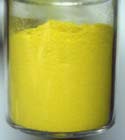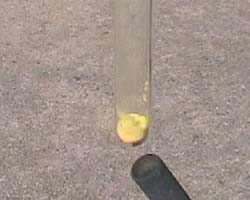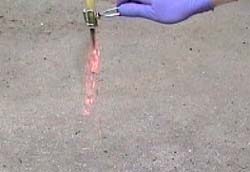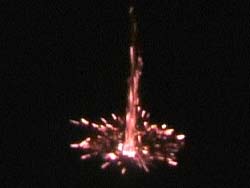Pyrophoric Iron
The pyrophoric Iron this article refers to is a form of very finely powdered Iron metal particles which can spontaneously ignite and burn when coming into contact with air. Iron naturally reacts with the Oxygen gas in the atmosphere to form Iron Oxide, otherwise known as rust. This natural oxidation reaction is very exothermic; however it is usually very slow under normal conditions. Increasing the exposed surface area of the Iron will result in the reaction proceeding much more quickly and giving off more heat in a shorter amount of time. By making the Iron particles into a very fine powder, the surface area available to react with the Oxygen in the air will be high enough to cause the particles to spontaneously begin to burn; at this point the Iron particles are pyrophoric.
Like the pyrophoric Iron, certain types of hand warmers employ the reaction between Iron powder and the Oxygen in the air to generate their heat. The Iron particles inside hand warmers, however, are sufficiently large to slow the oxidization reaction down enough so as not to catch on fire in an ordinary air atmosphere.
Producing Pyrophoric Iron
Pyrophoric Iron can be produced through the decomposition of Iron(II) Oxalate, FeC2O4, by heating. Upon heating, Iron Oxalate will decompose into Iron metal and Carbon Dioxide gas as in the reaction shown below.
When the decomposition reaction is performed properly one will be left with a finely powdered, pyrophoric, Iron metal powder.
Materials
- Iron(II) Oxalate (See ‘How to make Iron(II) Oxalate’ below)
- Test Tube (and Test Tube Clamp to hold test tube)
- Gas Torch
Procedure
Place a small amount of Iron Oxalate powder into a test tube and then heat the bottom of the test tube with a gas torch (for example a Propane torch). To reduce stress on the glass and decrease the chance of it breaking, try to heat the test tube evenly with the torch and do not place it too deeply into the flame.
It will not take long before the yellow Iron Oxalate begins to decompose leaving a black Iron powder behind. As the decomposition reaction proceeds the Iron Oxalate will give off Carbon Dioxide gas which will likely agitate the powder inside the test tube and cause some of it to be ejected along with the outgoing CO2 gas stream; it would be wise to avoid breathing these fumes. Initially, before the reaction really gets going, it may be necessary to gently shake the test tube so as to help the CO2 get to the surface and prevent gas pockets from developing in the powder.
In the video below, a small amount of yellow Iron(II) Oxalate is decomposed inside a test tube using a Propane torch to form black Iron powder.
|
Video
|
|---|
By its nature, the pyrophoric Iron produced during this process is very reactive with the Oxygen in the air. The Iron will easily oxidize if even small amounts of Oxygen are around. The shape of a test tube provides some protection for the pyrophoric Iron from the air. Since the Carbon Dioxide given off during the FeC2O4 decomposition is denser than air, the test tube will fill with the inert CO2 gas and act as a buffer between the highly reactive Iron powder and the Oxygen outside. While the Iron Oxalate is decomposing, the Iron powder produced is decently protected from the air (due to the positive gas flow out of the test tube), but once all of the FeC2O4 has decomposed Oxygen will diffuse inside and oxidize the Iron. One should not wait too long before using the Iron powder or moving it to an inert atmosphere.
Demonstration
In the two videos shown below, a test tube containing pyrophoric Iron powder is overturned and the powder allowed to fall out into the Oxygen atmosphere where is immediately begins to burn (seen as brightly glowing yellow sparks).
|
Video
|
|---|
How to make Iron(II) Oxalate
 Iron(II) Oxalate can be produced using a
water-soluble Iron salt and Oxalic acid. Iron Oxalate has a
low solubility so it may be easily precipitated by mixing
solutions of Fe+2 (aq) and Oxalic acid, H2C2O4.
Iron(II) Oxalate can be produced using a
water-soluble Iron salt and Oxalic acid. Iron Oxalate has a
low solubility so it may be easily precipitated by mixing
solutions of Fe+2 (aq) and Oxalic acid, H2C2O4.
Solutions of Iron salts such as Iron(II) Sulfate, FeSO4, and Iron(II) Chloride, FeCl2, would work well for preparation of Iron(II) Oxalate. Simply mix the Fe+2 (aq) and Oxalic acid solutions and yellow precipitate should form.
Ignoring the spectator ions, the reaction proceeds as follows,
Once the precipitation is complete, one can filter out and wash the Iron(II) Oxalate, then allow it to dry before crushing it into a powder.
Last updated:
03/16/2008





